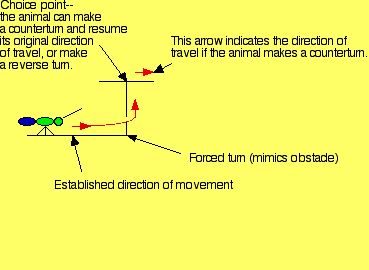Counterturning
| In this classic test for counterturning, a test animal is forced to establish a movement direction, running or walking down the arm of a maze. It then reaches a point where it must turn. After following the second branch of the maze, it reaches a decision point, at which it can make a counterturn, which re-establishes its original course, or make a reverse turn. In an experimental context, a number of animals can be asked to move through the maze, and the frequency of counterturns then can be compared with random (50:50) turning. The distance of the second arm of the maze and the time taken to traverse it affect the likelihood of counterturning; as distance and time increases, the animal "forgets" the needed course correction and is more likely to make a random choice. |  |
Early work on counterturning in milkweed bugs (Dingle***) set the stage for consideration of counterturning as a basic behavioral mechanism in animal navigation. Most of the recent literature which highlights counterturning as an important mechanism deals with how moths find odors (eg, Vickers 2000), but counterturning is probably displayed by most animals, if they are given the opportunity. Zeil (1998) found, for example, that fiddler crabs counterturn to maintain course constancy when their path is disrupted by moving a turntable on which the crab is walking.